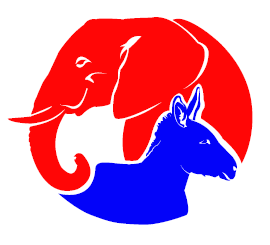How Polarized is America, Really?
BY GOVIN VATSAN
We constantly hear that the United States is becoming too “polarized.” The news media point to increasing and uncompromising partisanship as the defining character of the American political experience, and the basis of a “Culture War.” But while pundits fixate on polarization as the root of our nation’s political ills, such sweeping arguments are built upon misconceptions—and misrepresentations—of our nation’s political landscape.
In some respects, Americans are indeed becoming more polarized. According to a 2012 Gallup poll, the percent of Americans identifying as liberal and the percent identifying as conservative both jumped four percent between 1992 and 2011, while the percent identifying as moderate dropped eight percent over the same period. During this two-decade window, conservatives overtook moderates to become the largest ideological group in the United States comprising 40 percent of the population. But while these numbers demonstrate a trend towards increased polarity in our political system, an analysis of the breakdown of opinions on specific issues reveals that we may be oversimplifying this trend.
Let’s break down the numbers. According to a 2013 Gallup poll, the percentage of self-identifying economic conservatives has actually decreased by 2 percent over the past decade, while the percentage of economic liberals has increased by the same fraction. The perceived moral acceptability of most social issues has increased over the last 12 years, notably for gay rights (19 percent increase), births out of marriage (15 percent increase), and stem cell research (8 percent increase). Additionally, support for the legalization of marijuana has increased by a dramatic 35 percent since 1991, from one in six supporting legalization to one in two. On the conservative side, however, support for increased gun control legislation has dropped almost 30 percent, and support for abortion, the death penalty, and doctor-assisted suicide have all either decreased or remained unchanged. Regardless, these statistics cast doubt upon the common claim that Americans, as an entire population, have gotten more economically or socially conservative in recent decades.
So what drives the misconception about increasing polarization? First, although the overall ideological differences between liberals and conservatives may be small, the difference between the Democratic and Republican parties has grown. Over the last two decades, the percentage of self-described Democrats has stayed roughly stable, the percentage of Republicans has decreased from 31 to 24 percent, and independents grew from 29 to 38 percent of the American population. Moreover, over the last decade, the percentage of both moderate/conservative Democrats and moderate/liberal Republicans has decreased, largely due to absorption into the growing class of independents. This loss of moderate voters gave rise to ideological realignment within both parties and thus heightened partisanship. As a result, we are more likely to link conservatism with the Republicans and liberalism with the Democrats, leading to a conflation of the terms.
It is clear, though, that Congress is getting more polarized. According to recent statistics, both the House and the Senate are now more polarized than in any previous point in history. Political scientists reason that this bifurcation is caused by primary elections that are increasingly small and ultimately unrepresentative of the national electorate. The average percentage of eligible citizens voting in primaries has been steadily decreasing, down to less than 19 percent in 2010. This is down from over 30 percent in the ‘50s and ‘60s. In comparison, over 37 percent of the eligible electorate voted during the 2010 national mid-term election, almost twice the percentage that voted in the primary. This creates a far more partisan voter base for primaries, which in turn affects the ideology of the candidates sent to the national election.
Essentially, restrictive primaries give rise to extreme candidates. Consequently, in the general election the more moderate national electorate has to choose between candidates selected by the partisan few. Our elected officials thus hold views that are inconsistent with the majority of Americans, which results in a more polarized Congress. And when the media gets involved, polarization in Washington becomes confused with the polarization of the American populace. Political elites with strong and uncompromising party loyalties are able to manipulate average, under-informed American voters. Elites use the media as a tool through which to attack and accuse one another. Journalistic fixation on this back and forth then creates the illusion of widespread polarization. Ultimately, the American Culture War is not an organic outgrowth of ideological differences that divide ordinary Americans, but rather a myth manufactured by the symbiotic relationship between partisan politics and sensationalized media coverage.
